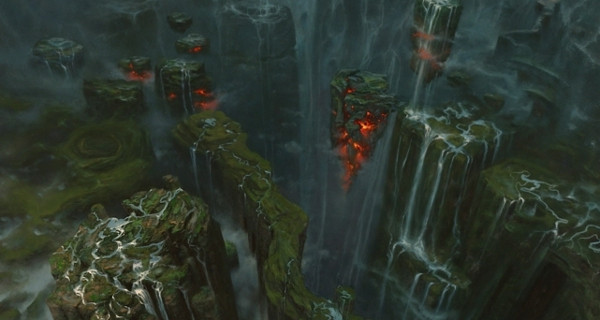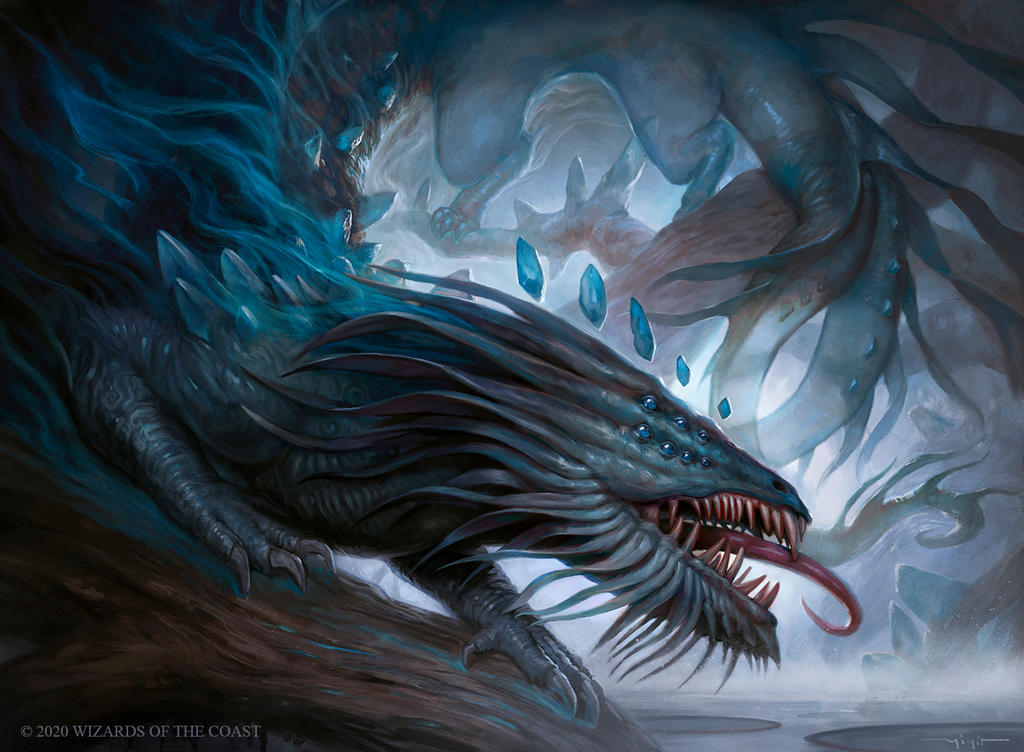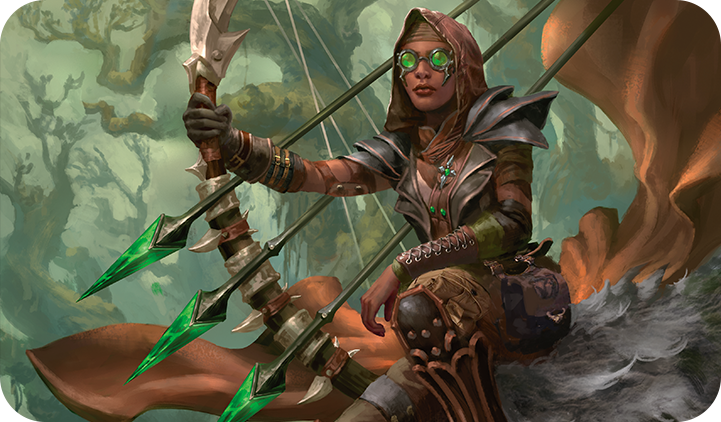As you can see, Zendikar is again in my cross-hair, and I can't get it out, so expect me to ramble about it even more!
In particular, I was thinking about my previous post and how the mechanic for the Roil could need to be simpler. So I am actually postponing a final version of it, to think more about the Player Character's experience, starting from character creation, and how this can actually shape the mechanics of the settings.
In particular, these I think should be the "tenets" of the Zendikar D&D experience:
- A focus on vertical exploration and combat, which means:
- Most characters should be able to move vertically somehow.
- Some characters should be able to provide vertical movement to those who can't.
- Omnipresent Roil: the environment can always change, which implies:
- Some characters can innately interact with the Roil (Merfolk, Surrakar, Goblin)
- Any character can learn the right skills to interact with the Roil (Lullmage feat)
- Some characters can specialize in the Roil (Roil Soul Sorcerers, Roil Mages, etc.)
- The Roil affects any encounter as a localized force, or travel as a regional force.
- A focus on small-scale adventuring, which means:
- Equipment is particularly important, and some tools and supplies should be extra-important. This means that...
- Environmental dangers, whether it's the Roil, traps, or hostile flora/fauna, sometimes damage/remove/eat equipment/supplies, making it important for characters to be careful when planning their expeditions' supplies.
- Hedrons are an integral part of the experience and can be:
- Equipment (pathway stones, hedron archives, hedron blades etc.)
- The focal point of Roil phenomena (and in this case, interacting with the Roil is like interacting with the hedron, and vice-versa).
- Having effects different from those of the Roil (and in this case, magic affecting the Roil can't affect the hedrons).
- Part of the scenery (when it's giant and/or inactive hedrons).
Now, speaking of Creeds, Cosi Tricksters could actually most probably manipulate the Roil too. But doing basically the exact opposite of Lull Mages. This could be a way of enabling Em's Flight, or Ula's Waters.
Cosi's Trick: as an action, you can spend a Hit Die and instead of regaining hit points, you can invert the state of a Roil's area of influence within 30 ft. of you. You can't use this feature if the Roil's state is Lull or Weird Lull.
And on to Ula's waters:
Ula's Waters: if you are within a Negative or Implosive Roil's area of influence, you can spend a reaction to attract water from below or above and give it a shape kept pressurized by the Roil. You can use it to propel yourself, and up to one creature within 10 ft of you, 20 ft in any direction, or grant you and the chosen creature three-quarters cover. After using this feature, you can't use it again until you finish a short or long rest.
Grotag's Lullaby: when you are within a Roil's area of influence in any Lull state (including Positive and Negative), you can spend an action to make a Wisdom or Charisma (Animal Handling) check to charm a beast within 10 ft. of you. The DC is equal to 10 + the number of Hit Dice of the beast. If you succeed, the beast is charmed as if under the Animal Friendship spell. If you fail, the beast becomes hostile and the Roil state worsens by one step. After using this feature, you can't use it again until you finish a long rest.
This is a funny one... Of course the Grotag's expertise with beasts was never officially tied to the Roil, but since I tie it to Lull states (and careful: this still means you need Roil to use it...), it can be easy to miss how the Roil is involved. The Grotags are basically finding a way to make the Roil help them in taming beasts, without even knowing. The fact the Roil worsens when they fail means the Roil is also connected to living things nearby, and an animal getting enraged makes the Roil enraged. Very Zendikarian!
Also, this brings me to a nice terminology for the Roil: to worsen or improve.
A Roil's state can always worsen or improve. This means changing the Roil Die number so that it's respectively farther or closer to the Lull state, by a certain number.
For example if a d8 Roil Die is on 6 (Positive Lull), worsening by one gives a 7 (Explosive Roil) while Improving by one gives a 5 (Lull).
A Roil's state can't worsen more than the maximum or minimum of its die.
With this terminology set, Lull magic becomes easier to phrase:
Lull Magic: as an action you can make a Wisdom (Survival) or Intelligence (Arcana) check to improve a Roil state affecting an area within 30 ft. If you succeed, its Roil Die improves by 1, and you can't use this feature again until you finish a short or long rest.
Continuing on the wave of Goblins, I would love to redo the Tuktuk tribe's feature based on the Roil. This is actually tricky, because it used to be based on the usage of Daily Arcane spells, if I remember correctly, so not just any spell, but I think we could convert it to just any spell of 1st level or higher.
Tuktuk's Fortune: when you take damage from a spell or magical effect of 1st level or higher within the the area of influence of a Roil state, as a reaction the Roil state briefly changes to its maximum, but you fly right outside of its area of influence in a random direction (use a d10, with 1 being directly upwards, and 10 meaning diagonally upwards, needing another roll for the direction.)
If the spell had hit you with an attack roll, it misses you, and if it affected an area and you move outside of it, you are not affected.
If you flew up, you still take falling damage as normal, unless you prevent it somehow.
The Roil's state returns to its previous state at the start of your next turn.
A bit wordy, but a lot of fun! It enables tactics like having the Tuktuk attract enemies near a Roil's epicenter (that's another nice term to use!), and then targeting it with a spell on purpose, to provoke a Roil Storm and affect the enemies in the area. Too bad there is a 20% chance the Tuktuk will take some damage, and a 10% chance the poor devil will take a LOT of damage (flying directly above, meaning landing/crashing within the Roil Storm just created..!)
After all...
"Survival rule 883: Fire distracts the eye of danger and warms the heart of fortune."
—Zurdi, goblin shortcutter
Note that since the epicenter is basically a point, one could also rule you just go out of the area in a straight line out of the epicenter, meaning "up" only if you are standing on it. But this could also mean the feature would be useless many times, since the goblin could already be very close to the border of the area, and in that case nothing much would happen, while the random flight actually gives more chances of being moved far away.
Lavastep's Grit: you are immune to the effects of Red Roil. When within the area of influence of a Black, Green, or White Positive or Explosive Roil, you can use an action to briefly change the Roil color to Red in a radius of 10 ft centered on you. The change lasts until the end of your next turn.
This is a bit cheesy and probably more at home with Roil Soul Sorcerers or Roil Mages, but it could be funny for these fiery goblins to actually bring the fire where they go. Blue Roil, being so elementally opposite, would be immune. And even Green honestly seems like a stretch. But changing White and Black Roil to Red seems really cool. I just wouldn't exactly know how would that "look" and "work" thanks to the Lavastep's "grit" mineral.
A possible solution could be making the Tuktuk feature belong to Lavastep (with the addition of immunity to Red Roil), and coming up with something more tame for the Tuktuk. Needs some thought.
By the way, this brings me to an easy write-up of the three Goblin tribes.
The basic race would be the official one from Volo's Guide to Monsters, but I would eliminate the Fury of the Small feature and include instead the following:
GROTAG TRIBE:
- Proficiency in Animal Handling
- Grotag's Lullaby
TUKTUK TRIBE:
- Proficiency in Survival
- Tuktuk's Fortune
LAVASTEP TRIBE:
- Proficiency in Arcana
- Resistance to fire damage
- Lavastep Grit
Note that Lavastep would get resistance to fire also because I see their feature as more situational and less universally useful than the others'. In addition, for another Goblin to gain such resistance would be easy: just eat as much grit as the Lavastep.
Also, if you're thinking power-creep, remember that all these features are very situational, since they depend on the Roil. Zendikar races are meant to be slightly better and have the extra power be tied to the Roil exactly because the Roil adds difficulty to the game: you lose some and you get some. Plus, the race becomes or remains useful enough in other settings only if these features are mostly on top of regular racial features, and not in substitution.
That's all for now! We have a more or less final general rule for the Roil, a nearly complete feat, cool features for Merfolk or Merfolk feats, and the Goblins.
Next I should complete the Merfolk!



























